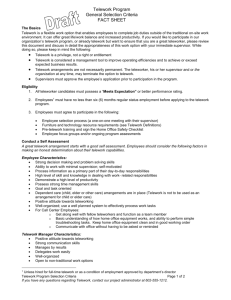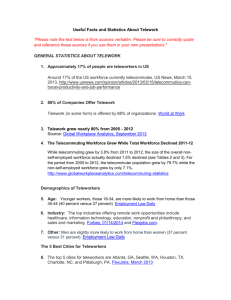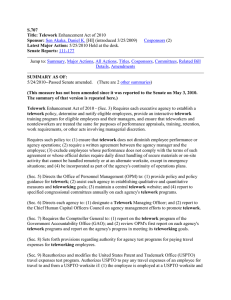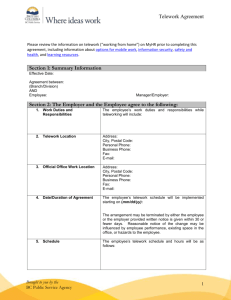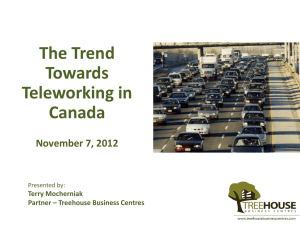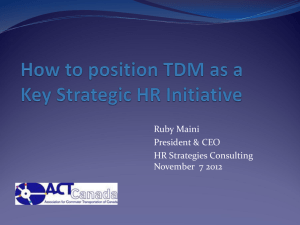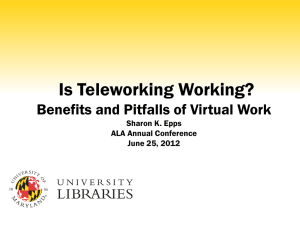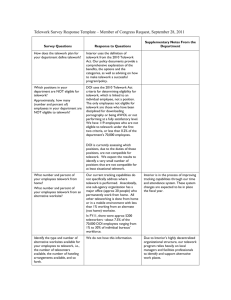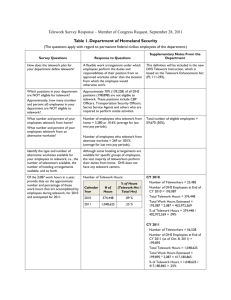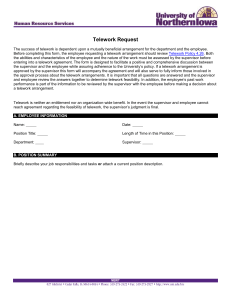Field working
advertisement
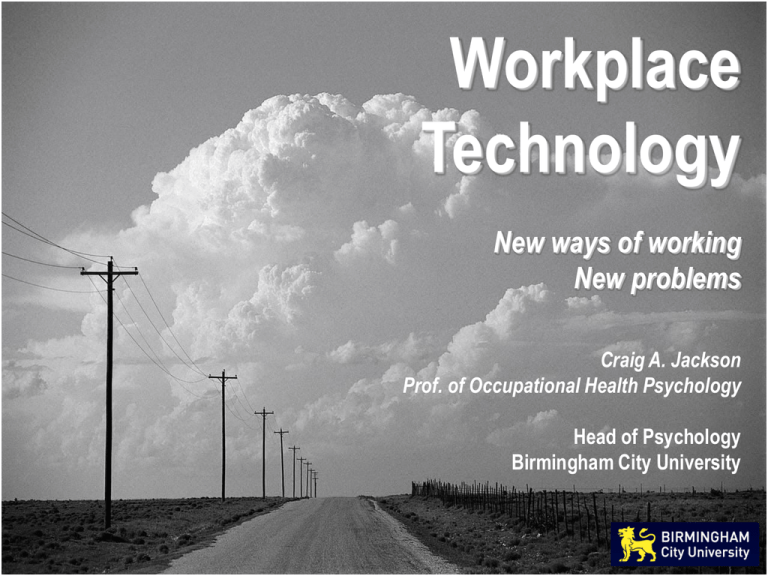
Workplace Technology New ways of working New problems Craig A. Jackson Prof. of Occupational Health Psychology Head of Psychology Birmingham City University Work Life Balance? Is this a reality? More of us working from home than ever More of us working on-the-road than ever Definitions Home-based working Employee is based at home, and has no designated office / workspace but may use “touch-down” centres and attend meetings with other team members in offices. Mobile-based working Employee has no designated office, and uses “touch-down” centres and ad hoc home working although not based at home. Field working Employees perform tasks while out of the office by using hand-held technology. Field working can be undertaken by employees with a designated office base, and those based at home. Expansion from older workplaces Factories Offices Shops Transport Expansion from older workplaces Factories Offices Shops Transport Expansion from older workplaces Factories Offices Shops Transport Expansion from older workplaces Factories Offices Shops Transport Gadgetaria Move from Pornography as biggest bandwidth traffic to Social Networking Cultural Significance “Podification” “cyber” Hooverization – “podcast” is generic term for “download” Hamburger status Gadget Porn “Stuff “ “It’s such a waste of working time . . . .” No peace from it Luke Williams I think they do spoil relationships & cause alot of arguments. My g/f has facebook (i do 2) and she seems 2 add more bois thn gals n the otha day i was lookin at hers n thers a new boi on ther n it sez thy hooked up n she sed she dnt kno who it is, i dnt kno wot 2 think? We also argue bare bout it...so i think it does cause problems. Overdone & Overused Cool versus Functionality paradox iPhone & Blackberry - converge Dilution of user-base Product loses identity Users look elsewhere Areas of Interest Established Teleworking Remote working Flexible working Home working Emerging Pervasive computing (GPS, RFID) Potential Virtual worlds (Second Life) Remote / Isolated Working ‘any situation or location in which someone works without a colleague nearby; or when someone is working out of sight or earshot of another colleague’ Field operatives Sales Drivers Lack of assistance available to the worker: illness accidents personal safety Social workers District nurses Filling stations Home workers Receptionists Cleaners Janitors Drivers Shops Security Teachers Engineers Expansion Telework rates in Japan Source: Ministry of Land, Infrastructure & Transport Benefits of Telework Organisational Cost savings (e.g. office costs down £6k/person/yr) Productivity increases of 10% to 40% Sickness absence reduction of circa 20% Wider employment pool Lower turnover & more flexibility Individual More flexibility – work / home life balance Reduced travel time & cost 7% report being happier Societal 60% of businesses start @ home – economic regeneration Less travel – lower carbon footprint Selection criteria for Telework Information gathering / processing roles rather than manual work A limited requirement to be in a designated place Minimal need for supervision Work that’s measured by defined objectives, milestones and outputs Work that needs high levels of concentration Work that doesn’t need any large business equipment Safety Issues for Telework Communication Risk assessment Equipment provision & maintenance Work organisation Information Training Incident reporting HSL Research Report 262/2004 Health Issues for Telework Ability to summon help if incapacitated Potential to work excessive or unconventional hours Weakening of boundaries between work & leisure Psychological impact of social isolation Fewer checks on unhealthy lifestyle activity Adverse effects on domestic relationships Telework & HSE Management Standards Demands No commuting but home distraction Control Higher level of discretion Support Risk of isolation Relationships Less conflict but harder to resolve Role Usually well defined / less clarification Change May feel “out of the loop” Case study #1 Two Virgin Cable engineers working in Ladywood, Birmingham. In a tent on a high street , repairing wiring in a junction box. Two local men approach, threaten them, ask them to leave. Men accuse workers of being undercover police. One of the men shows handgun in belt of his trousers. Virgin staff leave the area. Violence Risks Alcohol and drug use, by clients and members of the public with whom the lone worker comes into contact: people aggressive and their behaviour unpredictable. Geographical locations: certain areas of towns or cities known to have a higher risk of violence. Un-Social Hours working: working during these times carried an increased risk of violence as (i) generally fewer people around, (ii) greater number of ‘unsavoury characters’, (iii) people under the influence of alcohol or drugs. Nature of the job: some lone workers hold power / authority over customers / clients which can cause resentment and aggression. Violence Risks Clients or customer behaviour: for a number of reasons, clients / customers / public can be highly emotional, unpredictable or aggressive. Other people or situations encountered whilst doing job: include members of the public, young people, even animals and livestock. Travelling Visiting homes Carrying money or equipment Consequences of Violence Stress, anxiety, fear and depression: sometimes resulting from having to deal with persistent verbal abuse. Stress-related health problems: often leading to long-term sick leave. Psychological problems: exacerbated sometimes when employees may sometimes feel partly to blame for violent incidents, or feel they have failed in some way. Low morale and loss of confidence: in turn affecting an employees’ ability to do their job. Physical harm, trauma and injury, leading to sick leave. Case study #2 BT engineer attends elderly customer’s house to fix phone line No fault found with phone line Problem is the owner’s 1970’s telephone Engineer says new phone required and that the line works fine Customer refuses to let BT engineer leave Brandishes service revolver (Mark VI Webley) Held siege for two hours Training & Information Most predominant measure used Training Some sort of personal safety / violence prevention training was provided by all organisations; internal, external, formal, informal The key training messages conveyed were: • Do not go into a situation if you feel at risk • Use conflict resolution or defusing techniques • Be aware of surroundings • If you feel threatened, make your excuses and leave • Keep exit options open Effective Organisation of Telework Establish a schedule of contact channels Regular contact with manager (min. weekly) with face to face meetings (e.g. monthly) Attendance at team meetings (e.g. monthly) Use the telephone and not just e-mail Maintain work social circle (instant messaging, work networking sites, etc) Agree work packages and performance milestones Budget time to avoid extreme fluctuations in workload Make maximum use of workplace visits Ensure specific information is provided and used GPS Technology and Vehicles Benefits Efficiency in resource utilisation Duty of care for lone workers EMF Hazard Levels below ICNRP Public “Radiosensitivity” Psychological Issues Loss of autonomy & control “Spy in the cab” Super Snooper Sick Building Syndrome – A once popular theory Air quality Chemical pollutants Air con Ventilation Dust Tobacco Space Crowding Isolation Equipment Printers PC’s Noise Equipment Telephones Others Lighting Artificial Glare Control Job content vdu’s Monotony Overload Organisation Control, communication, feedback Is STRESS the common link with SBS? Computer Keyboards Tendonitis Repetitive Strain Injury Low Back Pain Carpal Tunnel Syndrome Cumulative Trauma Disorders Chronic Fatigue Fibromyalgia Irritable Bowel Syndrome Kerching!!!! Vocal Hygiene Golden Age of Communication Most jobs have increased vocal use Vocal load “unaware” Equipment modifications required Exacerbated by stress, alcohol, exposure “Revenge Effect” Campbell & Jackson 2006 Cyber Stalking Personal details Maps Accessible data Pictures “Googling” people Obesity & Techno-Decline CCTV for snoopers CCTV Erosion of civil liberties Reduced privacy Nothing to hide . . . Nothing to fear Feel safer? Reliability - - Ian Tomlinson / Dianna / De Menezes Korhonen et al., 2003. Offending Behaviour Fraud Violent pornography Fantasy sharing Paedophilia Virus Hacking Snooping Further Reading Campbell C, Jackson CA. Occupational Voice Disorders. Croner Health and Safety at Work Special Report 2006; 107: 4-8. Coupland D. Microserfs. Flamingo, New York 1996. Coupland D. J-pod. Bloomsbury, New York 2007. Crawford J, MacCalman L, Jackson CA. In Depth Review: The Health and Wellbeing of Remote and Mobile Workers. Occup Medicine, 2011; 61: 385394. Feynman RP What do you care what other people think?. Harper Collins, London 1993. Grossman, L. 2007. I take the iPhone Home. Time. Jackson CA, Crawford JO. Isolated and Remote Working. Management of Health Risks Special Report, 2006; 112: Jackson CA and Cox T. Health and well-being of working age people. ESRC Seminar Series. ESRC. London. 2006 Jackson CA. Psychosocial Aspects of the Workplace. In Aw, T.C et al. (eds) Occupational Health Pocket Consultant (fifth edition). Oxford: Blackwell Scientific Publishing; 2006. 191-201 Jackson CA. Psychosocial Hazards. In Smedley, J et al. (eds) Oxford Handbook of Occupational Health. Oxford. Oxford University Press; 2007. 167-179 Korhonen T, Ketola R, Toivonen R, Luukkonen R, Hakkanen M, Viikari-Juntura E. Work related and individual predictors for incident neck pain among office employees working with video display units. Occ Env Med, 2003; 60: 475-482. Lewin R. Complexity. Phoenix, London 1997. Olson, P., Laurent, L. 2007. iPhones Land in London. Forbes.com. (accessed November 9, 2008). Spuford F, Uglow J. Cultural Babbage: Technology, Time and Invention. Faber and Faber, London 1997. Tenner E. Why things bite back. Fourth Estate, London 1996.











